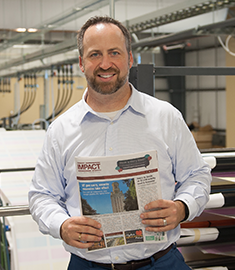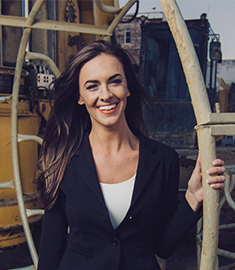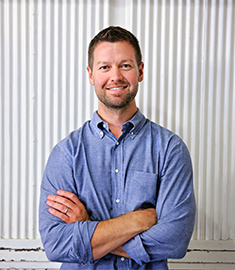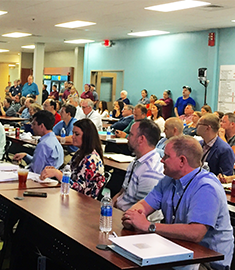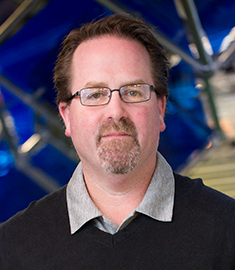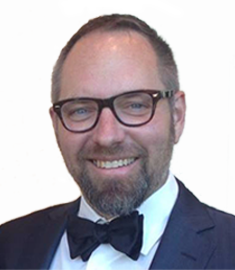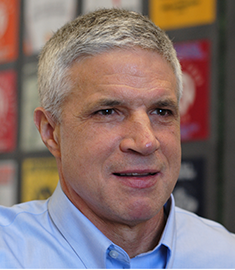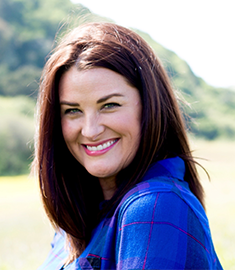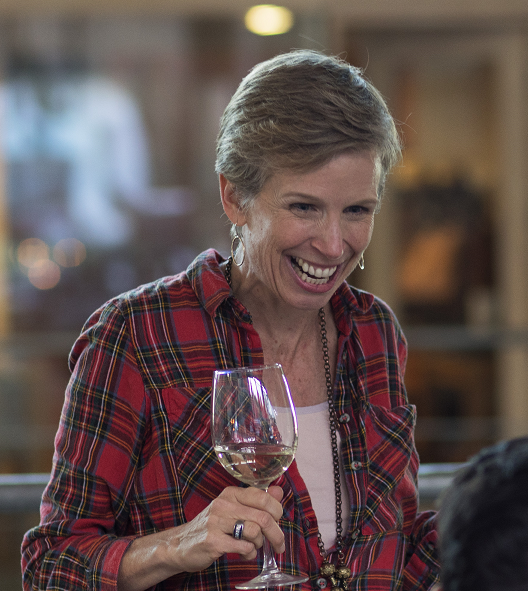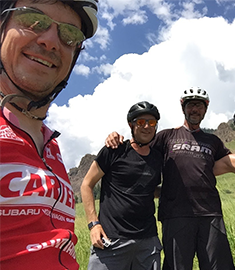How Saving Newspapers Made Me Evergreen
When I tell a new acquaintance that I'm in the print news business, I can predict the response: Their brow furrows. Their voice lowers. They offer their condolences: “Oh, I’m sorry.”
But me? I’m all smiles. Because I run a newspaper company that’s profitable and growing.
I cut my teeth in the industry on the advertising side, beginning with the Houston Chronicle in the glorious 1990s. Business was good, and I got a solid education in all aspects of the print media world.
Eventually my wife and I returned to our hometown of Pflugerville, Texas, and I went to work at the nearby Austin Business Journal. I noticed that information about local construction projects was scarce to none. The things that affected neighbors’ day-to-day lives — like when a road would be built, what kind of businesses would be allowed and whether there would be a Starbucks — weren’t being covered by the local media. These issues were newsworthy to our little enclave, but not, apparently, to reporters.
I had an idea: What if we built a business journal for the Average Joe? One that treated the opening of a new Mom-and-Pop pizza joint like it was news? Because on a neighborhood level, it is.
My wife agreed to support my burgeoning entrepreneurism. I sketched my thoughts out on a piece of paper, drew up a business plan and, armed with a $40,000 personal line of credit, set up shop in the game room of our house. A small group of writers and designers and I worked our butts off to crank out that first edition in September 2005. Then, we held our breath.
Back then, I couldn't even afford voice mail — I just had a caller ID box (remember those?). After the first issue was delivered, I saw that 10 businesses had called to inquire about advertising with us. Our next edition's ad space was sold out in two weeks. We’d found a formula that worked, and it still works today.
In our first five years, we grew like crazy, adding 10 papers and about 60 employees. As of October, we have launched our 23rd paper. We reach more than 1.7 million households around the state and have 185 employees. We expect to pull in $25 million in revenue this year.
Our business works because we have a strong central Purpose: to build communities of informed citizens and thriving businesses through the collaboration of a passionate team. We provide quality reporting without editorializing. We cover elections, but we don't endorse candidates. Readers appreciate that we care about what’s happening in their backyards. Local business owners appreciate our coverage. Advertisers appreciate having their messages delivered to their most likely customers.
Although my business may differ from other Evergreen entrepreneurs’ because of the publishing industry’s unique concerns, I’ve learned some lessons in the last decade that I think are broadly applicable:
A Little Dead Means A Little Alive
I firmly reject the notion that print is dead; my company is proof that it’s alive and well. While Community Impact Newspaper was growing by $5 million to $6 million in revenue a year, the traditional newspaper industry was well into its downward spiral. Digital ad sales couldn’t keep up with operational costs, so papers cut jobs. When they cut jobs, content suffered. And when content suffers, readership suffers. And without readers, you can’t sell ads. These papers continue to fold at a disheartening rate.
But that doesn’t mean you can’t come up with a better model. We don’t have a huge digital presence, but that gives us the freedom to not care about clicks. So we go to the city council meetings that traditional local media now ignores because they don't generate clicks online. We sometimes cover stories that only a small number of households care about. In the micro-niches we cover, print wins.
We’ve embraced Pragmatic Innovation to reach a highly engaged audience where they live: through their mailboxes. Using a fine-tuned targeting system developed in-house, we can deliver news — and serve ads — down to the carrier-route level.
Pay Now Instead Of Later
A trusted mentor once advised me to get libel protection. I took a chance and went without — and sure enough ended up getting burned. Insurance, lawyers, financial counsel — these are areas where the risks of cutting corners are too great.
This applies to staffing, too. Early on, we passed over a highly qualified candidate to fill a key position in the company to save money. Ironically, the person we hired instead ended up stealing from us. Luckily the person we should have hired in the first place was still interested, and remains with us today.
Own Your Own Destiny
With more than 20 papers and 50 people selling ads, the logistics of targeting and printing has become complicated. We built an internal system that allows for greater automation, but our printing vendor could not keep up. We needed our own plant, so we invested $15 million to build a state-of-the-art facility that will allow us to scale comfortably and effectively. We’ve bought inserting machines that help us target at the household level — something that would be very difficult with an outside vendor. Editorially, these presses allow us to deliver even more targeted, relevant news to our readers.
Investing in a printing plant in this day and age might seem crazy, but it gives us the tools we need to grow. I’d rather take the risk and own my own destiny than continue to rely on outside vendors who can’t keep up with what we need.
Lean In To Your Fear
As People-First entrepreneurs, we have to protect not only our own livelihoods, but also those of our employees. Do I sometimes break into a cold sweat worrying about that $15 million printing facility? Absolutely. But I believe that fear is good. It’s healthy. Because of my fear, I don’t take anything for granted, especially my people, without whom I would have no company.
Let’s be real: Business is hard, and every minute as a business owner — providing jobs, solving problems — is a blessing for which I thank God every day.
John Garrett is the CEO of Community Impact Newspaper.
What Evergreen CEOs Need To Know About Working With Millennials
I lived in my car on and off for nine months in 2009, when I was 21 years old. I slept in grocery store parking lots and spent 18 hours a day working for free in a city hundreds of miles from my home. All with the hope of starting a business in the real estate industry to fund my passion.
Does this bust any of your myths about millennial workers?
Since that cramped but productive time in my life, I have gone on to launch six successful businesses in Nashville, Tennessee. The Purpose of my Evergreen company, Aerial Development Group, has always been to empower people, sustain the planet and utilize capitalism as a force for good. I call this Excellence with Impact. We combine commitment to excellence in our products and services with dedication to impacting the world around us; we’ve sold over 290 homes, elevated 18 communities, sponsored 112 orphans in Africa and supported 12 local outreach programs.
And of the 28 people on my staff, 12 are millennials—my peers. I give them a lot of credit for our success.
Some stereotypes of millennials are based in fact. They need a lot of affirmation and attention. But with the right support they can become a major asset to your company.
Millennials are uniquely dedicated to personal development. They want to keep learning and rise within a company. Believe it or not, they are self-motivated and driven. But CEOs need to make sure they keep millennials focused on the broader mission of the company as well as their own achievements.
At Aerial, we have multiple strategies we use to manage millennials (as well as everyone else in our office). Specifically, we have a platform in place to make sure millennials are heard. Giving them time with management shows that we care about their growth as well as the growth of the company. This not only motivates them, but it also keeps our company sharp.
One tool we’ve found particularly effective is the Monday Morning Pow-Wow. Everyone has a chance to share their new ideas and suggest innovations—nothing is off the table. From assistants to executives, everyone receives equal respect in these meetings, and magic has had a tendency to enter the room during this time.
Then there’s the daily tool millennials particularly love called Align. The web-based management app lets everyone see the priorities of the company and the individual departments and then breaks down these priorities into specific tasks. It’s a nice, clear way for employees to see how everything they do contributes to the company’s goals.
We also do quarterly individual reviews to make sure everyone is working to achieve their goals as efficiently as possible. Although millennials tend to value Purpose over a paycheck, they can still be motivated by money. We always say, “We’ll give you a raise, but you have to show us why it makes sense for the company.” This is an empowering and educational exercise for all. It allows them to have some control over their rise in the company while also teaching them to think more like CEOs who understand the connection between raises and value creation.
It’s not all easy. I’ve found that I need to constantly remind my millennial employees of the big picture; otherwise they get bored and feel like they aren’t doing something with their lives. I have to show them why performing even a mundane task has meaning and contributes to the larger company and, sometimes, the world.
For instance, I recently went to Haiti to help set up an entrepreneurial program so the citizens there can create their own opportunity and won’t have to rely entirely on NGOs. When I returned, I had a meeting with my staff and showed them a video that reflects our company’s core values, why conscious business matters and how the work we all do will affect this particular project in Haiti. Through this little bit of extra effort, my entire staff was energized by my solo trip, and they feel good about staying home to keep the company going in my absence.
Make sure your Evergreen company has a Purpose, whether it is environmental or People First-oriented. This is what our generation demands. We grew up on Disney films in which the wealthy character was painted as the greedy villain every time. Millennials care deeply about the world and making it better. More than 75% of us say it’s important for a company to give back rather than just make a profit. We want our lives to affect others in a continuous and tangible way.
The Evergreen way will attract millennial clients and customers. A strong Purpose will attract and keep millennials as employees, as well. Open your doors to them. Mentor them. You’ll be astounded by their vision and capacity for change.
Your Evergreen company will be richer for doing so.
Britnie Turner Keane is the Founder and CEO of Aerial Development Group.
How Being Evergreen Helped Us Raise Millions To Fight Cancer
From the time I was 12, I knew I was going to be an entrepreneur. I had been running businesses of various types since I was in the sixth grade, including a student newspaper, which was shut down when the principal realized I was making money from it.
When I traveled around the world after college, I realized building a business to make money wasn’t going to be enough. My future business needed to have a strong Purpose that would allow me to give back while growing my company.
In 2007, when I was watching The Amazing Race on TV, I had an idea. I thought about how much I’d like to take part in an event like that, and I guessed other people would, too. I decided to start a business creating unique, fun events. Running had always been a passion of mine, and a few months later I launched the Great Urban Race as part of Red Frog Events. More than 150 people took part in the first run, and within a year I took it on a nationwide tour.
Until that point I had been working by myself from home. After the Great Urban Race, I brought my brother-in-law on-board to help and together we launched Warrior Dash, the first obstacle race series in the country to feature fire jumping and mud crawls. It was an instant success, selling out 2,000 spots within hours. We had pioneered a new industry.
As our company grew, we moved into an office space in Chicago complete with adult tricycles, candy machines and foosball tables. We were focused on the growth of the company but equally focused on creating a lasting culture for our employees. I decided that we would never sell the company or have an IPO — that we would embrace the Evergreen path, and with it, a better lifestyle for all of us.
Our customers were having fun at our events, and our business was growing in size and profitably. With our success, I felt it was time to start giving back, but I wasn’t sure which way to go. We partnered with St. Jude Children’s Research Hospital locally for one of our events in Denver, and it was then that I learned about their incredible, life-saving work. I fell in love with their mission. They were providing free cancer treatment to any child from around the world and producing groundbreaking medical discoveries. I knew we could make a major impact on the organization and was determined to figure out how we would incorporate them into each of our ventures. During the first few years of our partnership with St. Jude, we raised more than $5 million for the hospital through methods such as offering ticket buyers a chance to add on a donation to St. Jude.
A couple of short years later, I surprised the whole company by flying everyone to Memphis, St. Jude’s home, for our annual retreat. Touring the hospital and seeing kids who have to go through daily treatments affected all of us. That was the moment we, as a team, committed to something bigger. In 2013, we pledged to raise $25 million to help build and equip the St. Jude Red Frog Events Proton Therapy Center, the first center of its kind dedicated solely for child patients.
The St. Jude Red Frog Events Proton Therapy Center officially opened in December 2015. With proton therapy, doctors can precisely target cancerous cells while sparing nearby healthy cells and organs. Young children will no longer be subject to unfocused, high doses of radiation that can damage their developing brains.
Although we don’t require it, we encourage all our racers to fundraise for St. Jude. At each domestic Warrior Dash, participants who raise more than $300 receive access to a VIP area, complete with showers, a private tent and gear check. They receive extra benefits for giving back, and we donate all of that VIP package money to St. Jude. We also produce and host an annual Mardi Gras-themed fundraiser in Chicago, Beads for Hope, where all revenue goes directly to the hospital. We constantly work to raise awareness about St. Jude in all of our communications and events.
In 2012, the year before we made our big commitment, we launched Firefly Music Festival in Dover, Delaware. We knew it was a risky industry to enter and expected the inevitable losses we had in the first year. Word about our festival spread, and in Year Two we more than doubled in size with 65,000 attendees. I remember being on stage during the Red Hot Chili Peppers headline set with some other Red Froggers and exchanging quiet high fives. Today, solely through Firefly, a type of event that typically does not produce mass fundraising opportunities, we’ve raised nearly $200,000 for St. Jude through on-site donations and donations during the ticket-buying process.
We’ve already raised $13.5 million in three years towards our $25 million target. Because we stand on our own, we can take risks and keep our dedication to St. Jude at the core of our business. We regularly host visitors from St. Jude at our events and learn about the patients St. Jude treats. They keep us inspired. Our entire team will be going back to the hospital later this year, and we are well on our way to meeting our donation goal by our target date of 2022.
Joe Reynolds is the Founder and CEO of Red Frog Events.
Why Do So Many Evergreen CEOs Revere A Guy Who Fixes Diesel Engines?
Every fall, Tugboat Institute co-hosts its second major event of the year called the Tugboat Institute @ Evergreen Exemplar Visit. Last week, I traveled to Springfield, Missouri, along with 50 other Evergreen CEOs to learn about Jack Stack’s version of open-book management called the Great Game of Business (GGOB).
Why does his management approach resonate so deeply with us? Perhaps it is GGOB’s emphasis on People First and Pragmatic Innovation. Or perhaps it’s just the openness, honesty, empowerment and fundamental goodness that the system promotes—an echo of the employee relationship that many Evergreen leaders are working to build with their teams.
Stack doesn’t have an MBA or even a college degree, but he has been a gleeful student of business all his life. Like everybody’s favorite mad scientist, he’s been running experiments at his laboratory, Springfield-based SRC Holdings, best known for its skill at remanufacturing industrial engines.
In 1983, Stack and a few friends and fellow SRC employees put up $100,000 and borrowed $9 million at an 18 percent interest rate to buy the then-money-losing firm from dying International Harvester (IH). From the start, Stack took a radically different approach to managing SRC—one born of desperation, not genius, he insists. The day after the acquisition closed, Stack and his management team realized that they had forgotten to negotiate an IT agreement with IH. IH had turned off all their computer systems and access to all of their data from customer orders to payables.
So what did he do? He called all of his employees into the break room and line by line rebuilt their income statement and balance sheet together on a huge whiteboard. Everyone had to pitch in to help fill out the information. That “huddle” became the beginning of a weekly meeting with all employees to share the detailed financial information of the past week and to go over forecasts. They celebrated wins and addressed shortfalls.
He begged everybody—even the janitors—to help SRC get to profitability and to pay off the company’s bank debt. They didn’t have much time. He saw that few people understood the financials, so began training everyone on the team on the “rules of business,” using sports as the metaphor. How can a baseball team take the field if they don’t understand the rules of baseball? And, why will the team members engage if there isn’t a “scorecard” that shows whether they are winning or losing? And, why work hard and take the risk of suggesting improvements if they don’t have “a stake in the outcome?”
These three gamification ideas working together—teaching the rules of business, providing a clear scorecard and sharing in the success of winning—are the basis of the Great Game of Business.
Today, SRC’s equity is valued at hundreds of millions, the company has paid out over $100 million to retiring former employees, and thanks to its employee shareholder program, everyone in the company continues to benefit from SRC’s profitable growth. The 28 percent annualized return SRC has delivered over the past 33 years is superior to Berkshire Hathaway’s. More importantly, when we toured his facilities and watched his son lead a huddle, it was clear that people love working at SRC.
With the help of journalist and author Bo Burlingham, Stack has been hammering the drum of his version of open-book management for decades. Their 1992 book, The Great Game of Business, is a classic that every entrepreneur should read. Stack happily shared his wisdom with us over two exciting days, with Burlingham contributing a pearl of wisdom or a dig from time to time. From the first night we all gathered in the lobby of the Doubletree to learn about the great game, it was clear this was a group eager to play.
Like a lot of other Tugboaters, I was electrified when I first heard Stack tell his story, at Tugboat Summit in Sun Valley last year. I raced back to my bookkeeper and announced grandly that we would henceforth adopt open-book management. “What is it?” she asked. “I’m not exactly sure, but I want to try it,” I said. “Does it involve opening the books?” she asked. “Yes,” I said. “Well, we have less than $1 million in sales and three employees. So your idea is giving me a panic attack.” (Did I mention that I am married to my bookkeeper?)
Inspired by Stack’s early days, I experimented. I hunted for small ways I could give my employees a taste for the highs and lows of entrepreneurship. Like any company attempting to make a go of open-book management for the first time, we fretted over whether the system would fuel conflicts and jealousies.
It’s all been a bit clumsy at times, but my small team has embraced the game. I’ve seen them get excited about the rules of business and our numbers and feel the business buzz.
The Great Game of Business is a constantly evolving process, though. Did I come to Springfield with questions? You bet. Boy, did I get answers. I realized I was making this more difficult and less fun than Stack would have. First, you have to train people. Second, you have to get them working and interacting as a team. Stack and GGOB team member Steve Baker taught us that to make it work, you have to overcome the enormity of the challenge by making a game of it—literally.
In fact, Stack strongly encourages “mini-games” designed around 90-day goals that attack specific issues or opportunities in the business. Say the busboys in your restaurant chain carelessly throw away spoons to the tune of $10,000 a year. Create a “save-the-spoons” mini-game and reward the players with half of the gains through a progressively better set of gifts. For example, give a nice monogrammed mug to each busboy for hitting a modest goal and a French press for doing much better than that. Or suppose your bicycle manufacturer built two dozen folding bikes three years ago that are now unsold and unloved? Create a “brilliant mistake” mini-game to quietly usher the oddballs out the back door in steeply discounted private sales to cyclists with a sense of humor.
Our group was inspired and moved by the presentation. When we asked Stack what we could do to thank him for his hospitality and gift of his learnings he said, “Just buy me a beer the next time you see me. A Miller Lite would be preferred. And, care for your people and your families.” That’s the kind of guy Jack Stack is.
Stephane Fitch is the Founder of FitchInk.
How My Scars Led Me To The Evergreen Path
My journey to creating an Evergreen company began at MCI. Although it was a multibillion-dollar company, it operated like a startup, competing against industry giants such as AT&T in a David vs. Goliath environment.
It was the perfect starting point for me. My father, a career FBI agent, had told me that I was unlikely to ever join the bureau. But a friend of his, who worked in pharmaceuticals, told me I’d make a great salesperson. MCI gave me the chance to hone my sales skills, but after a few years I realized that to truly grow into a leadership position, I’d have to move beyond my MCI cubicle.
So when the opportunity arose to join a startup that was building an internet billing company, I jumped at the chance. This was 1995, when people were still skeptical of handing over their credit card details online. We had an innovative third-party solution, and our company, iBill, was an instant hit with revenues to match.
The company was a balance sheet success and grew to be a fairly large business, but when it was sold in 2002 after the dot.com crash, I didn’t have the big payoff that I’d dreamed about and felt the whole experience had been unsatisfying. Amazingly, although I was a founding member of the team — I had provided seed money and hired the team — I had less than 1% on exit.
It came as little surprise to me that two years after InterCept bought us, our company essentially went out of business. The experience was a lost opportunity. We could have been PayPal, but it never came to fruition.
The problem was, finances aside, we were not building a sustainable company. Instead of focusing on careful growth, we paid absolutely no attention to our customers and served every single dark corner of the internet. To keep up with the explosive growth of the internet, we made bad decisions in every area of the business — strategy, HR, execution, clients, etc. The upside: I learned a lot about a growth-at-all-costs mentality.
The company’s demise left me with plenty of scar tissue. It’s not a company I look back on fondly. I was determined to make sure the mistakes we made wouldn’t go to waste.
In 2007, we launched 3Cinteractive, a mobile consumer engagement platform that helps our clients build more profitable relationships with their consumers. To avoid past mistakes, I built my company around three main principles.
First, it would be sustainable. The business would take on little debt and have few investors. My partners and I would own it and be able to make all of the decisions.
Second, I wanted to focus on doing something important for world-class clients. At iBill, we had taken on any client we could get (embarrassingly most of them ended up being porn sites) rather than making sure we had a core group of reputable business partners. Now we proudly call Walgreens, Disney and Best Buy our clients.
Finally, and most important, I wanted to support and nurture my employees. After iBill’s sale, it was the staff that lost out the most, and I wanted to build a learning culture where I could work with great people and treat them fairly.
It hasn’t all been smooth sailing at 3Ci, and that’s when our principles have mattered the most. Bad experiences, market downturns, ill-advised hires and miscalculations could have killed us if we had not lived by our principles. They have guided our decision-making and helped our company achieve greater success for all of us.
They also have given voice to our employees and stakeholders at important junctures. For example, when we were deciding to take on modest debt, our employees rightly questioned how this move would create customer value and opportunities for greater returns, and not put our business at unnecessary risk. That debt has since been paid back.
We encourage these kinds of discussions because they mean our employees have a sense of ownership and are growing along with the company. When I see our employees with stacks of books on their desks to further educate themselves, I love their aspiration and strive to help them in every way I can.
The lessons I learned from my first failure have helped build a strong culture, and we hope that by continuing to follow the Evergreen path, we will make good decisions and build a long lasting, principle-driven company together.
John Duffy is the Founder and CEO of 3Cinteractive.
How Sustainable Chocolate Helped Me Find My Purpose … And My Profit
After I dropped out of high school during my senior year, I went looking for adventure.
I set sail in an old wooden boat without a motor, and while traveling around parts of Central America, I fell in love with Southern Belize. The lush Maya Mountains, the barrier reef and the amazing, diverse people won my heart.
In the late ’80s and early ’90s, Southern Belize was very remote and felt like the end of the world. It was there that I began volunteering for a small conservation foundation protecting important plant species and learning about Maya sustainable agricultural practices. With nothing but a strong back and boundless curiosity, I worked with the Maya on their cocoa farms, hunted with them and went on rain forest expeditions to support conservation work.
During my time in Southern Belize I saw that social, environmental and economic degradation are business problems. It became clear to me that if cocoa farmers were paid a better price for their crops, their lives would improve. They would be able to pay for school for their children and access better health care.
This issue was not unique to the cocoa farming families of Southern Belize. This was an industry-wide problem. I knew I needed to take action, and over the next decade I worked to bring organic cocoa beans to the United States and promote fair trade farming practices, building relationships with farmer groups.
In 1994, I imported my first container of organic cocoa to North America and pioneered the organic chocolate market. My company had tremendous top-line growth. I was investing heavily in developing the cocoa supply in Latin America and Africa, contracting with manufacturers in the U.S. and abroad and working hard to stay ahead of constant cash demands. At that time, I was singularly focused on the mission of my business. To achieve the largest impact, we paid high prices to farmers in return for high-quality cocoa beans, invested in training for sustainable tropical agriculture and often financed the harvest itself to ensure that farmers had a decent cash flow in places where credit was unavailable.
But that meant we were working on razor-thin margins. The downward pressure on price, combined with the fact that we didn’t control a consumer-facing brand, plus the high cost of raw materials and financing meant that we never made a profit.
That was fine in the ’90s. But when the financial market dried up in 2001, we weren’t able to carry on. I had missed what was really necessary to build a sustainable business — profit.
I wanted to create a business that demonstrates that people, planet and profit not only can coexist but that long-term success requires equal investment in all three. I believed that our business could be a powerful tool for positively impacting everyone from farmers and the landscapes they steward to chocolate lovers worldwide.
In 2004, I founded Theo Chocolate. At the time, Theo was the first and only bean-to-bar maker of organic, fair-trade-certified chocolate in North America. By controlling our brand, manufacturing and key raw-material supply chain, we are able to retain greater margins, pay better prices to farmers for high-quality cocoa and sell our products at competitive prices.
Every decision we make as a business reinforces the idea that doing the right thing should never be the rare thing. Our values at Theo permeate everything we do, and the people who buy and enjoy our products do so in part as a reflection of their own personal values. To me, we have created something more powerful and meaningful than excellent candy bars.
Theo’s mission is simple but profoundly ambitious: We’re dedicated to making the world a better place based on shared values and a shared love of cocoa. The only way for us to truly deliver on the promise of our brand is to grow as a business and make investments in our long-term potential. I believe that my vision requires Theo to be an Evergreen business. Staying independent and investing in our future success is the only way that we can build the next great American chocolate company.
Joe Whinney is the Founder and CEO of Theo Chocolates.
Taking The Field: My Journey To Evergreen Success
The best thing my father ever did for me was tell me I couldn’t come back to the farm.
I was 22 at the time and had just graduated from Ohio State University with a degree in horticulture. As the oldest of eight kids, I always thought that I would one day run our family farm. But at the time, the farm wasn’t making much money, we had no room to expand, and between my father and his brother (who was his partner on the farm), there were 16 hungry children to take care of. My father needed one fewer mouth to feed, not another partner.
At the time, I was terrified. But looking back, it’s the best curveball life ever threw at me. I had always had an entrepreneurial bent; now I had to go out and make it on my own. Through the years, the Evergreen ideal of Pragmatic Innovation has inspired me to stay nimble and find new ways to thrive in an ever-changing market.
When I started out on March 17, 1977 (St. Patrick’s Day, I have some Irish in me), with nothing but a pickup truck, a few shovels and a lawn mower to my name, I went into lawn maintenance. On the farm, we grew sod, so I asked our sod customers if they needed lawn help. Most said no, but a few said yes, and I was in business.
I quickly realized that there was limited upside in residential care. Most people wanted their lawns mowed on Friday to look good for weekend events, and there were only so many lawns I could do in one day. But commercial properties needed full-time maintenance to keep up their curb appeal through the week.
My residential customers helped me land some commercial clients, and that’s how I met John Sawyer, an owner of the Cincinnati Bengals who also had a commercial office park. He was one of my first customers with whom I worked out a yearly contract instead of just charging per cut. John was impressed with our work, and in 1982, after the Bengals’ first trip to the Super Bowl, he asked if I could help improve the turf at the team’s training ground.
It was in terrible shape. There was a 3-foot elevation difference across the field. The pasture grass was in horrendous condition. But I saw an opportunity. I had been interested in the work of a professor I knew at Purdue University, Dr. Bill Daniel, who had devised a manual system of subsurface vacuum pumps that could quickly whisk away water after a storm or irrigate the field from underneath to keep the grass healthy during the dry season.
It was an expensive proposition, but Sawyer was willing to take a risk on it. My team worked day and night to get that field installed correctly. It was a huge challenge, and I loved every minute of it.
That job improved our reputation with local high schools and universities and helped supplement our commercial grounds-care business (which continued to grow). But by the late ‘80s, the job was no longer fun or challenging. More players were entering the market, and it was quickly getting commoditized, pushing prices down. We no longer had enough to differentiate us, and I was working around the clock just to make a modest return.
So I took the bold step to sell off the majority of our business except the sports turf work, the only part of our portfolio where we were differentiated and that I still truly loved. It was a big risk, but in order to grow, I knew we had to stand out. The vacuums on the field we had built for the Bengals had to be operated by hand, which took a lot of oversight. I saw this drawback as an opportunity. I purchased the original technology from Daniel, and we then huddled with my research colleagues at Ohio State to devise a system that could remove or add water with the push of a button from anywhere.
Once we had a functioning system prototype, I leveraged my relationship with the Bengals to work with other NFL teams. The Miami Dolphins wanted to improve their ability to handle Florida’s monsoon rains. They also wanted the grass at their stadium, which also is the home of the Marlins, to look like Augusta National Golf Club’s. We damned near killed ourselves installing that field. A hurricane hit mid-project, and in 20 minutes we lost weeks worth of work. But in this business, opening day is opening day — it can’t be pushed back. So, we worked around the clock to get back on track to finish within the 43-day window we were given before the Marlins’ first pitch.
The system, which is now patented as Prescription Athletic Turf, was a success and led to many jobs with other teams, including the Baltimore Orioles, the Los Angeles Dodgers and the Atlanta Braves. But that didn’t mean I could sit back and watch the grass grow while my company grew around me.
I realized that as good as our new systems were at managing the water through weather extremes, we now had issues with keeping the well-used grass in place. I went back to the drawing board, and with the help of my research team came up with a synthetic-grass hybrid that has the look and feel of natural grass along with the anchoring strength and durability of synthetic turf. This patented product, called Eclipse, helped us land additional stadiums in the U.S. as well as the 2000 Summer Olympics in Australia. That put us on the world stage for stadiums looking for high-end natural turf systems.
But life threw me another curveball a couple of years later.
Through the mid ’90s we’d ridden a wave of replacing AstroTurf, which was rough and led to lots of player injuries. Synthetic grass wasn’t really something I worried about. That was until I went to Nebraska in 1998 and saw a new kind of artificial turf. It was shockingly good. I just about died when I touched it because I knew this wasn’t a fad — this could put me out of business.
We pivoted again. Our hybrid research had taught us a lot about synthetics, and we were able to develop our own synthetic, which plays like natural grass. Today we have more than 300 fields using our branded synthetic products.
Like all Evergreen companies, we continue to have our ups and down, but I strive to keep my team focused on the future, always trying to read the tea leaves to predict what the market will throw at us next. We love being in the curl of the wave. Our team today is 85 members strong and ready to tackle Pragmatic Innovation challenges, which has given me the ability to step back from the front firing line just a little and focus on our long-term strategy.
When I think about my father, who died three years ago, I know he was proud of what we’ve achieved at my company. He was my greatest mentor and coach. He pushed me into the game and showed me that I had it in me not only to compete on the big stage, but to win.
Joe Motz is the President and CEO of The Motz Corporation.
What Bootstrapping My Budding Business Taught Me About Hiring
In 2010, I quit my job as director of alumni relations at Stanford Law School to pursue my dream to start a business that did something good in the world. My goal was to disrupt the $3 billion e-commerce flower industry while helping local flower growers and providing a better option, both environmentally and aesthetically, for consumers.
Most people don’t realize that the majority of flowers sold here are flown in from other countries, often coated in chemicals that are illegal in the U.S. On top of that, the flowers are at least a week old. Online flower options are limited and expensive. I personally found it frustrating that when I wanted to order flowers for my mom in rural Indiana, I was relegated to choosing from online designs that just didn’t match my personal preferences. After researching, I found I wasn’t alone in my frustration. I wanted to fix this. After all, sending flowers is essentially sending love to someone, so it should look like love went into the floral design.
I launched Farmgirl Flowers from the dining room in the San Francisco apartment I shared with my boyfriend with $49,000 of my own savings. My big idea was to design one daily bouquet made with seasonal, locally grown flowers. I also wanted to build an integrity-driven company that hired the right people and treated them well; this included a full-time team with full health benefits and workers compensation, and investing in them, so they’ll be invested in the future of the company.
After pitching to over two dozen venture capital firms rather unsuccessfully, it seemed like the best way for me to ensure my long-term vision for my company was to go Evergreen.
This means that not only do I have to be extremely careful with our cash flow, but I also have to be very strategic with our growth based on how and when we can afford to fund it using our profit. I see that as one of our strengths, though, and not a weakness. For example, it took me three years longer than I anticipated to launch national shipping because it took me that long to save enough money to self-fund the program. I also opened and closed a second location within a year because it wasn’t working. And, because I don’t have a cushion of several million dollars of investment money in the bank, I have to quickly identify what’s working and not working.
Bootstrapping my business has also taught me a lot about finding and retaining employees in today’s culture. I hired my first worker when I was still in my apartment, meaning I had to find someone I could trust to handle the day-to-day assistant tasks while I established literal and figurative boundaries between my work and personal space.
Now, as my company blooms, I am faced with new challenges. I have to adapt to a local work culture in which I am in desperate need of loyal, hard-working young people who are content with non-tech salaries, in the most expensive city in the U.S. I need to retain them for longer than the six to 12 months this demographic currently tends to stay in positions so that we are not constantly turning over good talent. We’re a business that needs to be able to scale to 10x daily sales for key holidays and be able to attract temporary talent for those times throughout the year. And, without funding, I don’t have a robust executive team to help carry the load. I like to joke that I’m the entire C-suite. To say this is challenging would be a bit of an understatement.
Hiring is always a learning process. But by going through that process myself instead of relying on financial backers to direct me on what roles to hire and when, I’ve been able to better understand my company and our true needs. I can’t afford to be wasteful with even a dollar, so everyone wears lots of hats, which I think makes us much stronger as a team.
Instead of fancy perks, I invest in incentives that I believe are more important for growing the business. For instance, instead of free lunch, I saved to be able to afford full medical insurance for the team. We don’t have fancy bubbly water in the refrigerator, but I’m working on getting a 401(k) alternative set up for my employees.
I also feel that being Evergreen has provided me with a rich sense of community, a ticket into a club that I never would have known existed. I love my network of female founders who support one another’s private companies and whom I rely on for input in my decisions.
Lastly, I don’t believe success has anything to do with level of outside funding. Farmgirl Flowers succeeds because of the quality of our products and our superior team. And you can see that in our financials, as well. Farmgirl Flowers has increased its revenue by at least 200 percent every year since its inception.
And for the skeptics who say Farmgirl cannot grow quickly without venture funding, we are expecting to hit between $10 million and $11 million in revenue this year, up from $4.4 million last year, and we are profitable.
Now that’s something to celebrate.
Christina Stembel is the Founder and CEO of Farmgirl Flowers.
Keeping Family In The Picture At My Evergreen Business
Each bottle of Kingston Family Vineyards wine shows the front door of our home in Chile. It represents five generations of family in the Casablanca Valley, beginning with my great-grandfather Carl John Kingston’s elusive search for copper and gold in the early 1900s near Santiago. Generations later, the Farm still serves as the cornerstone of our family business. Today we open the same door of the casa patronal, built more than a century ago, and invite our customers to explore our estate-grown vineyard in the heart of Chile’s wine country.
Since we started our farm in the 1920s, we’ve made the conscious decision to keep our family in the picture. Although I live in the San Francisco area with my husband and three daughters, that Chilean century-old farmhouse in the middle of 8,000 acres is also my home. I’m there every other month and for a year, we lived there full time and sent our kids to school with their Chilean primas. It’s where the five branches of my extended family gather for special occasions and where many of us spent summers riding horseback as children.
Mixing family and business can be a challenge, especially when you’re building a company for the long run. Many Evergreen entrepreneurs worry about family dynamics in the workplace — not wanting to taint their business with their family, or their family with their business. As a next-generation leader of the Farm, I work closely with my father, brother, sister-in-law and Chilean uncle and aunt. I’ve had to set clear personal and professional limits and learn to listen in ways that I never would have had to do in the corporate world. Most important, I’ve had to find a different way to lead.
I started my career working for digital media companies such as CNET in Silicon Valley. With a Stanford MBA under my belt, I got a charge out of working in the fast-paced, go-go world of the early internet in the late ’90s. But when I turned 30, I hit a wall. The tech world began to feel like a game, and I desperately wanted to switch to something that was more meaningful to me.
When my brother Tim asked me to help get the vineyard off the ground, I jumped at the chance. At that time, the Farm focused mostly on dairy and beef cattle, supplying 5% of the fresh milk to the nearby capital city of Santiago. We had dealt with the vagaries of commodity pricing for two generations.
Our idea was to diversify into managing a top-quality hillside vineyard, and focus on less-common grape varietals like pinot noir and syrah. If we built a reputation as a world-class vineyard, we could create a sustainable business and help insulate the Farm from the booms and busts of Chile’s export economy.
Tim took a board seat and as president, I led sales and marketing. My father, Michael, stepped in as our CFO. My uncle Enrique managed daily operations at the vineyard and Farm, and my aunt Sally managed everything related to the extended buildings and grounds.
In a corporate context, there would have been a clear hierarchy with annual reviews, raises and promotions. Now, we had to provide that internal feedback to one another. That’s hard enough to do with a business partner, but even harder when the person to whom you’re giving feedback is your father.
At first, my dad wanted to work nights and weekends, and he gently chided us for not doing the same. But my brother and I were both raising young families, and it was important to us that we had time set aside away from work. To overcome our conflict, we had to sit down and talk honestly — not always the easiest thing to do with family members. But with time, and lots of practice, we got better at it.
Now we’re very careful about when we’re on work time and when we’re on family time. We try to make sure we don’t discuss the Farm on family time. During my wedding weekend in 2003, we hung a sign on the front door of our family home that said, “This is a wine-free zone” to discourage everyone from talking business (not from drinking).
We’ve also learned that family members often work best together when we have our own independent, yet complementary, businesses. Each generation needs to lead in its own way. In 2003 we started Kingston Family Vineyards, our own wine label from our estate-grown grapes. Our top-rated Kingston Family wines further elevate our vineyard’s brand.
We continue to sell 90% of our vineyard production to other Chilean winemakers. Uncle Enrique is uniquely positioned to oversee those key local relationships. Our own winery is a vineyard client (with most-favored nation status). Over the last 10 years, I’ve led our direct-to-consumer distribution strategy in the U.S., a unique business model for a small Chilean winery.
Luckily, I’ve never had to persuade our family that we should be Evergreen. We’ve been focused on the long term from the beginning, with no interest in outside investors. Now that I’ve led our family business for 15 years, I can’t imagine wanting to do anything else. The benefits that come from working with your loved ones far outweigh any tensions we’ve had to overcome. There’s no one I’d rather be building my Evergreen business with.
Courtney Kingston is the Founder of Kingston Family Vineyards.
Rucks, Family And The Power Of Listening: Learnings From Sun Valley
Almost 100 businesspeople went to Sun Valley, Idaho last week for the annual Tugboat Summit. I was one of them. I went hunting for concrete ways to make my company stronger, to grow it at a reasonable pace while remaining purposeful and putting my people first. In other words, to become more Evergreen.
Now, as I write this on a cross-country flight home, I face the task of unpacking an enormous haul. I pore over my pile of inspiring insights, new relationships, novel directions and constructive exercises. Then it hits me. Commander Rorke Denver is a damned genius.
Rorke spent more than a decade fighting in Afghanistan and Iraq. He survived countless battles and watched good men die for a cause that didn’t always make sense. He spent many days with a rifle in his hand, multiple radios strapped to his chest and a pack of heavy gear on his back. He thought deeply about what lessons — large and small, literal and figurative — he could take home to share with the rest of us. One of the best ones Rorke presented to us in Sun Valley was about that heavy pack: “Choose your ruck wisely,” he said. Pick one that won’t tempt you to overpack.
Post-summit, I think I may be coming home with an oversized ruck. But it’s hard not too. The annual summit is like a Middle Eastern bazaar of mind-expanding business ideas and inspiring stories. I didn’t want to leave any good ones behind.
I got to hear my old friend F.K. Day tell the story about the life-changing insights that he, his brother and a few friends gained stumbling through the early years of building Chicago-based SRAM, now the second-largest maker of bicycle parts in the world. One of the most compelling lessons: Get close to your customers and listen to them. Their feedback will make you a better innovator.
I got to hear celebrated entrepreneur Amy Simmons, founder of Amy's Ice Creams in Austin, Texas, explain how she regards her Evergreen approach to business as a powerful antidote to the widely-held view that capitalists have a “fuck you, I got mine” attitude. Amy is one of many Evergreen owners who insist on sharing key financials with employees. She is a relentless community-builder and philanthropist. She helped a Texas cancer center build a game room that resembles an ice cream shop and has freezers stocked with frozen treats for the young patients and their families.
Then there’s artist Phil Hansen, famous for his 2013 TED talk, “Embrace the Shake,” who reminded me that “creativity sucks.” That’s his shorthand way of saying that if you rely only on true “bolt from the blue” moments of inspiration, you’re in trouble. It’s important to come up with systems that can dependably produce incremental creative breakthroughs — practical innovations, if you will.
For every idea I got from a formal presentation, I picked up two more in casual conversation. Melanie Dulbecco, chief executive at San Francisco-based R. Torre & Company, makers of Torani syrups, inspired me with a passing suggestion that my colleagues and I create a picture — an actual, physical image — of our shared vision for our firm’s future. I expect us to be sharpening our colored pencils in the weeks and months to come. Darcey Croft, founder of beauty-products startup Barenaturals, challenged me to set aside my reticence to self-promote. Carrie Van Winkle Greener, founder of Pappy & Company, reminded me that one of the most powerful sources of new business ideas and energy is one’s own family. The list goes on and on.
If you didn’t attend the summit, the good news is that you’ll be reading about all of these ideas and watching all the presentations in the coming weeks and months in the Evergreen Journal. Hell, I’ll be reading the EJ and reviewing the presentations myself, just as a way of refreshing my mind. But still … There’s something about being at a Tugboat event that is hard to capture. And I’m not just talking about how we all went skeet-shooting in Sun Valley.
What is it? Dave Whorton, the former venture capitalist who started Tugboat, recently explained it to me when I wrote about the Evergreen movement for Sun Valley-based magazine BigLife. Most Evergreeners, he says, are “lone eagles.” Eagles almost never flock. “But in extraordinary circumstances — once a year in Haines, Alaska, for example — they do flock,” he said. And like eagles, when Evergreeners get together, “amazing things happen.”
Stephane Fitch is the Founder of FitchInk.
